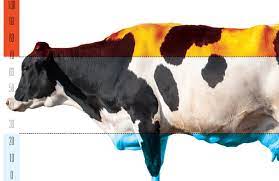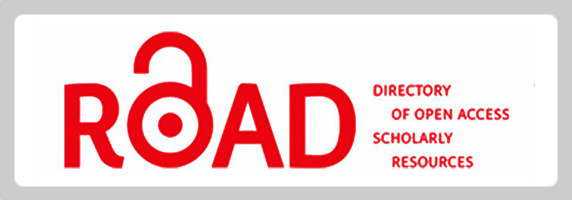the Effect of Rumen-Protected Niacin and Vitamin C Additives on Productive Performance of Suckling Friesian Calves Under Heat Stress Condition
Additives for Suckling Calves
Abstract
This study aimed to evaluate the effect of rumen-protected niacin and vitamin C on suckling Friesian calves' productive performance under heat stress during the summer season. Twenty-four newly born Friesian calves with an average live body weight of 31±0.21 kg is assigned into four comparable groups. Calves were unsupplemented in G1 and served as control, or supplemented with rumen-protected niacin at 2g/head/ day in G2, vitamin C at 2 g/head/day in G3, or rumen-protected niacin at 1 g/head/day plus vitamin C at 1 g/head/day in G4 during suckling period (105 days). Results confirmed that G4 recorded appreciably (P<0.05) the very best digestibility coefficients of all nutrients, feeding values, TVFA’s attention and decrease notably (P<0.05) Ph price and NH3-N awareness accompanied with the aid of G2 and G3, whereas G1 had the different trend. Blood biochemical and hematological values had been substantially (P<0.05) the highest, however, the exercise of liver enzymes (AST & ALT) was appreciably (P<0.05) the lowest in G4 accompanied by using G2 and G3, however, the lowest counts performed in G1. Group four recorded considerably (P<0.05) the very best TDN and DCP intake, weaning weight, whole, and daily weight gain, feed conversion ratio, and financial affectivity accompanied by G2 and G3, alternatively G1 had the lowest values. In conclusion, either rumen-protected niacin or vitamin C and its mixture had an effective role in improving the growth performance of suckling Friesian calves under heat stress.
Downloads
References
Abd El-Monem, U.M. and Kandeil, M.A. (2011). Effects of chromium piclonate and ascorbic acid supplementation on growth performance, carcass traits, blood constituents and picture of growing kids under the summer conditions. BS. Vet. Med. J., 21, 15-21.
https://doi.org/10.21608/jvmr.2011.77656
Aengwanich, W. (2002). Effect of age on hematological values and blood profile of Holstein Friesian crossbred in Northeastern Thailand. Suranaree J. Sci. Technol., 9, 289-292.
Anantasook, N.; Wanapat, M.; Cherdthong, A. and Gunun, P. (2013). Effect of plants containing secondary compounds with palm oil onfeed Intake, digestibility, microbial protein synthesis and microbialpopulation in dairy cows. Asian-Australas. J. Anim. Sci., 26, 820-826.
https://doi.org/10.5713/ajas.2012.12689
PMid:25049855 PMCid:PMC4093251
AOAC (1995). Official Methods of analysis, 16th Ed., Association of Official Analytical Chemists, Washington, DC, USA.
Aragona, K.M.; Chapman, C.E.; Pereira, A.B.D.; Isenberg, B.J.; Standish, R.B.; Maugeri, C.J.; Cabral, R.G. and Erickson, P.S. (2016). Prepartum supplementation of nicotinic acid: Effects on health of the dam, colostrum quality, and acquisition of immunity in the calf. J. Dairy Sci., 99: 3529-3538.
https://doi.org/10.3168/jds.2015-10598
PMid:26898282
Bendich, A. (1989). Antioxidant vitamins and their functions in immune responses. In: Antioxidant Nutrients and Their Immune Functions (Eds A. Bendich, M. Phillips and R.B. Tengerdy) Plenum Publishing Co. New York, U.S.A. pp. 408-421.
https://doi.org/10.1007/978-1-4613-0553-8
Bendich, A. (1992). Ascorbic acid and immune functions. In: Ascorbic Acid in Domestic Animals (Eds C. Wenk, R. Fenster and L. Volkerl) Institut fur Nutzlierwissenschaften, Zurich, Switzerland.
Despopouols, A., and Silbernagl, S. (2003). Color Atlas of Physiology. 5thedition. Completely revised and expanded. Thieme, Stuttgart, New York.
El-Neney, BattaaA.M. and El-Kholy, K.H. (2014). Effect of natural additive (bee pollen) on immunity and productive and reproductive performances in rabbits. 1- Growth performance, digestive and immune responses in growing rabbits. Egypt. Poult. Sci., 34:579-606.
https://doi.org/10.21608/epsj.2013.32572
Farooq, U.; Samad, H.A.; Khurshid, A. and Sajjad, S. (2011). Normal reference hematological values of one-humped camels (Camelus dromedarius) kept in Cholistan desert. The Journal of Animal and Plant Sciences, 21: 157-160.
Gaafar, H.M.A.; Gendy, M.E.; Bassiouni, M.I.; Shamiah, S.M.; Halawa, A.A. and Abu El-Hamd, M.A. (2011). Effect of heat stress on performance of dairy Friesian cows.1- Milk production and composition. Researcher, 3: 85-93.
Ghosh, C.P.; Kesh, S.S.; Tudu, N.K. and Datta, S. (2017). Heat Stress in Dairy Animals - Its Impact and Remedies: A Review. Int. J. Pure App. Biosci., 5: 953-965.
https://doi.org/10.18782/2320-7051.2577
Hall, M.B.; Larson, C.C. and Wilcox, C.J. (2010). Carbohydrate source and protein degradability alter lactation, ruminal, and blood measures. J. Dairy Sci., 93: 311-322.
https://doi.org/10.3168/jds.2009-2552
PMid:20059929
IBM SPSS Statistics (2020). Statistical package for the social sciences, Release 27, SPSS INC, Chicago, USA.
Jezek, J.; Nemec, M.; Stari, J. and Klinkton, M. (2011). Age related changes and reference intervals of haematological variables in dairy calves. Bull. Vet. Inst. Pulawy, 55: 471-478.
Kibler, H.H. (1964). Environmental physiology and shelter engineering. LXVII. Thermal effects of various temperature-humidity combinations on Holstein cattle as measured by eight physiological responses. Res. Bull. Missouri Agric. Exp. Station. pp. 862.
Kumar R. and Dass, R.S. (2006). Effect of Niacin supplementation on growth, nutrient utilization and blood biochemical profile in male Buffalo calves. Asian-Aust. J. Anim. Sci., 19: 1422 - 1428.
https://doi.org/10.5713/ajas.2006.1422
Kume, S.; Tohamat, T. and Kobavashi, N. (1998). Effect of restricted feed intake of dams and heat stress on mineral status of newborn calves. J. Dairy Sci., 81: 1581-1590.
https://doi.org/10.3168/jds.S0022-0302(98)75724-8
Luo, D.; Gao, Y. and Lu, Y. (2019). Niacin supplementation improves growth performance and nutrient utilization in Chinese Jinjiang cattle. Ital. J. Anim. Sci., 18:57-62.
https://doi.org/10.1080/1828051X.2018.1480426
McDonald, P.; Edwards, R.A.; GreenhaIgh, J.F.D. and Morgan, C.A. (1995). Animal nutrition. 5th Ed., Copyright licensing LTD., London.
Mohammed, A.K.; Mohammed, G. and Akerejola, O.O. (2007). Haematological and serum biochemical changes in Bunaji work bulls after farmland ridging exercise in Kaduna state, Nigeria. J. Anim. Vet. Adv., 6: 576-579.
Mostafa, M.R.M.; Abou-Elenin, Ebtehag, I.M.; Abdou, A.A. and Riad, W.A. (2015). Effect of thiamin or niacin supplementation into the rations of growth fattening calves on their productive performance. Egyptian J. Nutrition and Feeds, 18: 373-382.
https://doi.org/10.21608/ejnf.2015.105823
NRC (2001). Nutrient Requirements of Dairy Cattle. 7th rev. ed., National Academy Press, Washington, DC.
Politis, I.; Hidiroglou, M.; Batra, T.R.; Gilmore, J.R.; Gorewit, R.C. and Scherf, H. (1995). Effects of vitamin E on immune function of diarycows. American Journal of Veterinary Research, 56: 179-184.
Sallam, S.; Nasser, M.; Yousef, M.; El-Morsy, A.; Mahmoud, S. and Yousef, M. (2005). Influence of aluminum chloride and ascorbic acid on performance, digestibility, caecal microbial activity and biochemical parameters of rabbits. Res. J. Agri. Biol. Sci., 1: 10-16.
Sarker, M.S.K.; Ko, S.Y.; Lee, S.M.; Kim, G.M.; Choi, J.K. and Yang, C.J. (2010). Effect of Different Feed Additives on Growth Performance and Blood Profiles of Korean Hanwoo Calves. Asian-Aust. J. Anim. Sci., 23: 52 -60.
https://doi.org/10.5713/ajas.2010.90280
Sayed-Ahmed, I.E.; Abd El-Monem, U.M.; Al-Sagheer, A.A. and Khalil, B.A. (2018). Effect of ascorbic acid supplementation on performance of growing rabbits under Egyptian conditions. Zagazig J. Agric. Res., 45: 263-273.
https://doi.org/10.21608/zjar.2018.50067
Schneider, B.H. and Flat, W.P. (1975). The evaluation of feeds through digestibility experiments. Athens: The University of Georgia Press, PP. 423.
Scott, G.H. (1981). What is animal stress and how is it measured. J. Anim. Sci., 52:150-153.
https://doi.org/10.2527/jas1981.521150x
PMid:7240033
Smith, T.R.; Chapa, A.; Willard, S.; Herndon, C.; Williams, R.J. and Crouch, J. (2006). Evaporative tunnel cooling of dairy cows in the southeast: Effect on body temperature and respiration rate. Journal of Dairy Science, 89: 3904-3914.
https://doi.org/10.3168/jds.S0022-0302(06)72433-X
Tag El-Din, T.E.H.; Hassan, R.H.; Abo-Egla, El-Samra and Hanaa, A.B. (2008). Effects of vitamin C and/or folic acid supplementations in alleviating the negative effects of heat stress in local laying hens. Egyptian J. Anim. Prod., 45: 333-346.
https://doi.org/10.21608/ejap.2008.104525
UCDAVIS (2001). Clinical Chemistry Reference Intervals. Veterinary Medical Teaching Hospital. University of California, Davis, USA.
Van Keulen, J. and Young, B.A. (1977). Evaluation of acid -insoluble Ash as a natural marker in ruminant digestibility studies. J. Anim. Sci., 44: 282 - 287.
https://doi.org/10.2527/jas1977.442282x
Van Soest, P.J. (1994). Nutritional Ecology of the Ruminant, 2nd edn. Cornell University Press, Ithaca, New York.
https://doi.org/10.7591/9781501732355
Warner, A.C.I. (1964). Production of volatile fatty acids in the rumen, methods of measurement. Nutr. Abst. and Rev., 34: 339.

Copyright (c) 2022 Nabil Mohamed Eweedah, Atef Yousif Salem, Hamed Mohamed Gaafar, Ahmed Shaban Shams, Reda Abd Albary Mesbah, Imad Fawzy Aljadba

This work is licensed under a Creative Commons Attribution-NonCommercial-NoDerivatives 4.0 International License.










